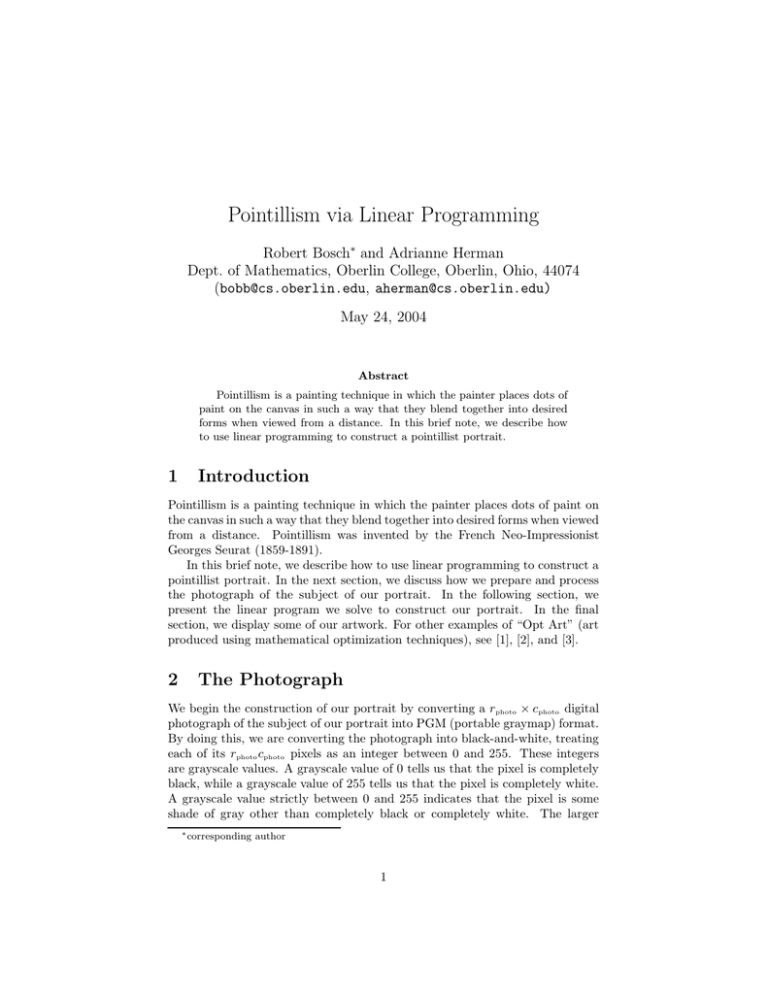Pointillism via Linear Programming
advertisement

Pointillism via Linear Programming
Robert Bosch∗ and Adrianne Herman
Dept. of Mathematics, Oberlin College, Oberlin, Ohio, 44074
(bobb@cs.oberlin.edu, aherman@cs.oberlin.edu)
May 24, 2004
Abstract
Pointillism is a painting technique in which the painter places dots of
paint on the canvas in such a way that they blend together into desired
forms when viewed from a distance. In this brief note, we describe how
to use linear programming to construct a pointillist portrait.
1
Introduction
Pointillism is a painting technique in which the painter places dots of paint on
the canvas in such a way that they blend together into desired forms when viewed
from a distance. Pointillism was invented by the French Neo-Impressionist
Georges Seurat (1859-1891).
In this brief note, we describe how to use linear programming to construct a
pointillist portrait. In the next section, we discuss how we prepare and process
the photograph of the subject of our portrait. In the following section, we
present the linear program we solve to construct our portrait. In the final
section, we display some of our artwork. For other examples of “Opt Art” (art
produced using mathematical optimization techniques), see [1], [2], and [3].
2
The Photograph
We begin the construction of our portrait by converting a rphoto × cphoto digital
photograph of the subject of our portrait into PGM (portable graymap) format.
By doing this, we are converting the photograph into black-and-white, treating
each of its rphoto cphoto pixels as an integer between 0 and 255. These integers
are grayscale values. A grayscale value of 0 tells us that the pixel is completely
black, while a grayscale value of 255 tells us that the pixel is completely white.
A grayscale value strictly between 0 and 255 indicates that the pixel is some
shade of gray other than completely black or completely white. The larger
∗ corresponding
author
1
the grayscale value, the lighter the shade of gray. Note that at this point, our
photograph can be thought of as a list of rphoto cphoto integers, each one between
0 and 255.
Next, we compress our photograph. (We reduce both the number of integers
in our list and the largest integer in our list.) First, we find positive integers
rportrait and cportrait and a small positive integer k such that rphoto = krportrait and
cphoto = kcportrait . (If necessary, we crop the photograph.) Next, we divide the
canvas into rportrait rows and cportrait columns of unit squares, and we partition the
pixels of our photograph into rportrait rows and cportrait columns of k × k squares
of pixels. Then, for each row 1 ≤ i ≤ rportrait and column 1 ≤ j ≤ cportrait of our
photograph, we compute the mean grayscale value µi,j of the pixels in square
(i, j) and set
gi,j = γ − bγµi,j /256c,
where γ is a positive integer. By doing this, we are defining gi,j to be the
average darkness of square (i, j) of our photograph on a 0 (completely white)
to γ (completely black) gray scale. Note that at this point, our photograph can
be thought of as a list of rportrait cportrait integers, each one between 0 and γ.
Figure 1 illustrates this “photo processing.” Figure 1(a) is a portion of a
photograph of DaVinci’s Mona Lisa (her right eye). Figure 1(b) is a table of the
resulting gi,j ’s. Here rphoto = 40, cphoto = 32, rportrait = 20, cportrait = 16, k = 2,
and γ = 9.
Figure 1: (a) A portion of DaVinci’s Mona Lisa, (b) the resulting gi,j ’s
3
The Linear Program
The pointillist painter paints a portrait by placing dots of paint on the canvas,
placing the dots wherever he or she chooses, making each dot as dark as he or
she pleases.
We construct a pointillist portrait by placing disks of tinted glass on the
canvas. We assume that the canvas is completely white. We do not allow
ourselves to place disks wherever we wish; instead, we force ourselves to place
one disk at the center of each square of the canvas. All of our disks have radius
ρ, and all are the same thickness. All of our disks have constant opacity, but
we allow the opacity to vary from disk to disk. To do this, we let xi,j equal the
opacity of the disk centered at square (i, j). The opacity of a disk is the fraction
of light the disk absorbs. So if xi,j = 0, the disk centered at (i, j) is completely
transparent. If xi,j = 1, the disk is completely opaque.
Once we have assigned values to the xi,j ’s, it is easy to compute the darkness
of any point on the canvas. We define the darkness of a point to be the combined
opacity of the disks that cover it. Suppose, for example, that a beam of light
is aimed at the center of square (2, 4) in figure 2. This point is covered by two
nontransparent disks, each having opacity 1/3. Two thirds of the light passes
through the first disk. And two thirds of the light that passes through the first
disk passes through the second disk. So four ninths of the light passes through
both disks, which means that five ninths of the light is absorbed. Consequently,
the darkness of the point is 5/9. The general rule is that the darkness equals
one minus the product of the complements of the opacities of the disks that
cover the point (e.g. 95 = 1 − (1 − 13 )(1 − 31 )).
Figure 2: ρ = 2, x3,3 = x3,5 = 31 , xi,j = 0 for all other (i, j).
Now that we know how to compute the darkness of any point on the canvas,
we can talk about how to compute the darkness di,j of any square (i, j) of the
canvas. One possibility is to construct a darkness function that takes as input
the coordinates of a point and returns as output the darkness of that point. If
we had such a function, we could integrate it over all points in square (i, j) to
get the darkness of square (i, j). Unfortunately, if we do this, di,j will end up
being a very complicated nonlinear function of the xi,j ’s. Another possibility is
to define
Ci,j = {(i0 , j 0 ) : 1 ≤ i0 ≤ r, 1 ≤ j 0 ≤ c, (i0 − i)2 + (j 0 − j)2 ≤ ρ2 },
the set of all squares (i0 , j 0 ) within ρ of square (i, j). Note that we are measuring
from center-of-square to center-of-square. Then we could set
Y
(1)
(1 − xi0 ,j 0 ).
di,j = 1 −
(i0 ,j 0 )∈Ci,j
But here, too, di,j is a nonlinear function of the xi,j ’s. A third approach—the
one we adopted—is to use a linear approximation of equation (1):
X
di,j =
xi0 ,j 0 .
(i0 ,j 0 )∈Ci,j
Now we are finally ready to present the linear program we solve to construct
our portrait. Clearly our goal, in plain English, is to place our tinted disks
in such a way that the canvas ends up resembling our photograph as much as
possible. In mathematical terms, our goal is to assign values to the xi,j ’s that
make each γdi,j term (the darkness of square (i, j) of the canvas on a 0-toγ scale) as close as possible to the corresponding gi,j (the darkness of square
(i, j) of the photograph). One way to do this is to solve the following nonlinear
programming problem:
X
(NLP)
minimize
|γdi,j − gi,j |
i,j
subject to
di,j =
X
xi0 ,j 0
∀i, j,
(i0 ,j 0 )∈Ci,j
0 ≤ di,j ≤ 1
0 ≤ xi,j ≤ 1
∀i, j,
∀i, j.
The problem (NLP) can be “linearized” using a standard trick described in
most textbooks on linear programming (see page 222 of [4], for example). For
each absolute value term, |γdi,j − gi,j |, we introduce a variable zi,j and two
constraints, zi,j ≥ γdi,j − gi,j and zi,j ≥ −γdi,j + gi,j . We end up with the
following linear program:
X
(LP)
minimize
zi,j
i,j
subject to
zi,j ≥ γdi,j − gi,j
∀i, j,
zi,j ≥ −γdi,j + gi,j
∀i, j,
X
∀i, j,
xi0 ,j 0
di,j =
(i0 ,j 0 )∈Ci,j
0 ≤ di,j ≤ 1
∀i, j,
0 ≤ xi,j ≤ 1
∀i, j.
Note that at optimality, zi,j will equal |γdi,j − gi,j |. Also note that linear
program (LP) has 3rportrait cportrait variables and 3rportrait cportrait constraints.
4
Results
Figure 3 displays two examples of our pointillist artwork. We constructed them
by solving the linear program (LP), running version 6.6 of CPLEX on an 800 Mz
Pentium III PC. Figure 3(a) is based on a photograph of a portion of DaVinci’s
Mona Lisa, and Figure 3(b) is based on a photograph of a portion of Vermeer’s
Girl with a Pearl Earring. For each piece, we used r = 90, c = 70, k = 2, ρ = 2,
and γ = 9. For figure 3(a), the solution of (LP) required 12158 seconds. For
figure 3(b), 15586 seconds were needed. For figure 3(a), the optimal objective
value was approximately 905.81; for figure 3(b), it was 782.93. Consequently,
for figure 3(a), the “average error” (i.e. the average of the |γdi,j − gi,j | terms)
was 0.14378. For figure 3(b), the average error was 0.12428.
Figure 3: (a) Mona Lisa, (b) Girl with a Pearl Earring
References
[1] Bosch, R. 2002. Domino Artwork. http://www.dominoartwork.com.
[2] Bosch, R. 2003. Dominizing Venus. OR/MS Today. April 20-21.
[3] Bosch, R., A. Herman. 2004. Continuous line drawings via the traveling
salesman problem. Oper. Res. Lett. 32 302-303.
[4] Chvátal, V. 1983. Linear Programming. WH Freeman, New York.




